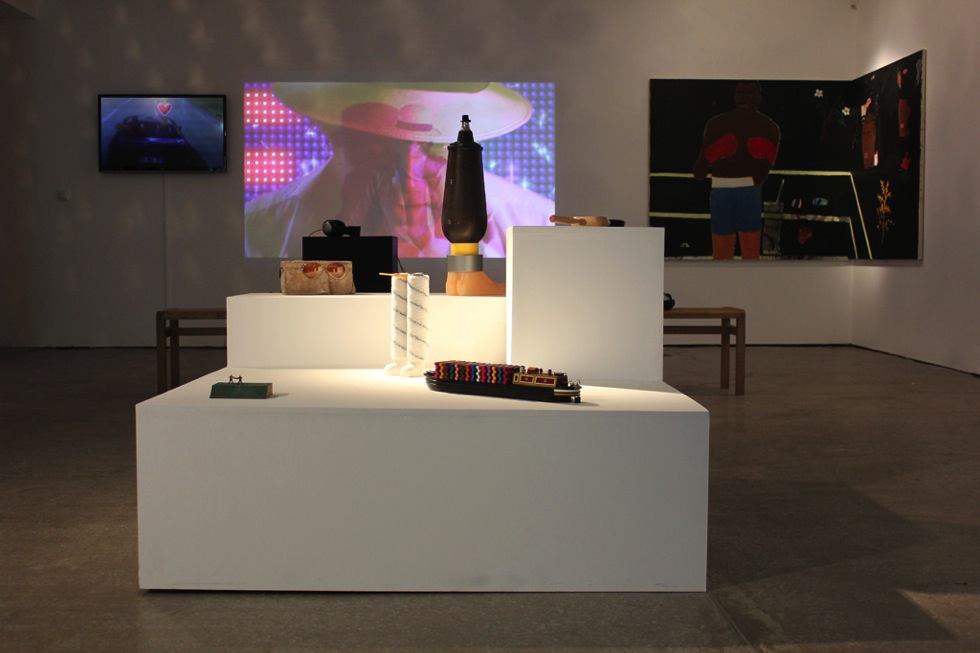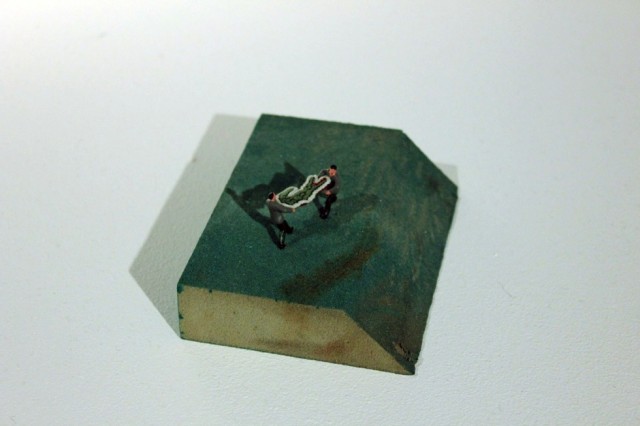30 Years Of The Future — Reviewed

Who shapes the future of contemporary art? Polly Checkland Harding considers the skill of predicting the next big thing at Castlefield Gallery’s anniversary exhibition…
Look back at photographs of Sensation, the Saatchi Gallery’s controversial exhibition at the Royal Academy in London, and you realize two things. First, that more often than not the artists who exhibited there in 1997 have gone on to become key players in modern art’s performative evolution; and second, that it is a remarkable thing for an exhibition to feel so prophetic. It is perhaps also remarkable that I was taken to see it at nine years old; that I was witness to a calf that had been split lengthways, to a zoomed-in bullet wound and to a bed that made the papers. Nevertheless, when Tracey Emin went on to make more headlines and a tattletale tent, I felt I knew (literally, at least) where she was coming from.
Now, almost exactly 17 years later, and around 200 miles to the North West, Manchester’s Castlefield Gallery has opened an exhibition that is equally forward-thinking. The artists showing in 30 Years of the Future are not names that many will have heard of – yet. They have, however, come to the attention of some of the most prominent figures in the art world today: to celebrate 30 years of following and fostering emerging artists, Castlefield Gallery has handed over total curatorial control for this exhibition to 14 high-profile ‘nominators’, each of whom are part of the gallery’s own history. These nominators were asked to choose someone they think will shape the future of contemporary art. What’s striking is just how unknown, and yet how compelling, the selected artists have turned out to be.
Sue Webster, one part of creative duo Tim Noble and Sue Webster, describes how she discovered Danny Fox — whose large, graphic, Picasso-esque canvases were her pick for the exhibition. “Danny Fox invited me to his studio,” she explains. “I realized immediately that this was no usual studio but in fact a tiny and lonely bed-sit with piles of ambitious-looking paintings stacked against all four walls… I felt a duty to exhume these unseen masterpieces before their author died a tiny little death.” Now, Fox’s paintings are on display in an influential gallery alongside works that are nearly all as provocative – in varied, inventive ways.

Take two of the most absorbing video works (of which there are many), as an example. In the Upper Gallery, Place of Dead Roads by Josh Bitelli and Felix Melia collages tactile, textured shots of leathered motorbike covers and dead plants with the steady procession of two men sat in tandem on a moped, travelling through dusty, deserted streets. The transparent flag they carry makes liquid creases in the wind behind them; here, symbolism and implied loyalty have both been voided. The six-minute film is a potent study of abandonment, liminality and distorted views, one that’s hard to turn away from. In the Lower Galleyr, Jay Delves’ Improvisation for a Sports Club grips in a different way: here, the ritual absurdity of sport is deconstructed through slow, reiterated action.
30 Years of the Future is a project that has bumped 15 unfamiliar artists a little further towards recognition, with the help of figures such as Ryan Gander, the gallery’s new patron and the artist behind two major exhibitions in Manchester last year, and Hans Ulricht Obrist, Director of International Projects at the Serpentine Gallery. Yet the key to the success of this show – to whether it fulfills the prophetic insistence of its title – is, in many ways, no longer in the hands of the nominators.
On opening night, artist and Research Professor at MMU Pavel Büchler gave a speech in which he argued that Castlefield is “the one gallery that tries to create something you can be part of.” Like Magnus Opus, a past artwork by Gander where a reactive, animatronic pair of eyes express disappointment when you stand inanimate too long before them, Büchler points to the public’s place in the picture. In this instance, the audience is important to the future that’s being predicted: when a gallery presents and promotes artists that are working among us, here and now, the audience’s engagement has a very different impact to when old masters are in the frame. We, at least partly, decide whether this is what the future looks like.
Here, the works themselves encourage interaction – both literally, where there are headphones to wear, and through the buzz of ideas that surround them. A plinth in the Lower Gallery contains six works by Timothy Foxon that are a comic and curious play on strangeness. Foxon’s pieces, which include a toy barge bearing crayons as though for a massive baby, and two tiny men carrying the Lacoste Croc logo (above), have a punning quality to them – they feel like fun puzzles to work out. Works like this accumulate to make this, Castlefield Gallery’s most ambitious exhibition to date, feel less like a prediction, and more like a definition.
Which raises the question: did the subsequent success of Charles Saatchi’s Sensation come down to prophecy, or persuasion? Look closely at this blurred boundary and it becomes hard to say. Either way, I’m left hoping that 30 Years of the Future is right.
Polly Checkland Harding
This article has been specially commissioned for The Double Negative by Liverpool John Moores University and Arts Council England. Part of the collaborative #BeACritic campaign — see more here
30 Years of the Future at Castlefield Gallery: showing until 1 Feb 2015. Gallery open Wed-Sun, 1-6pm. Free, just drop in






